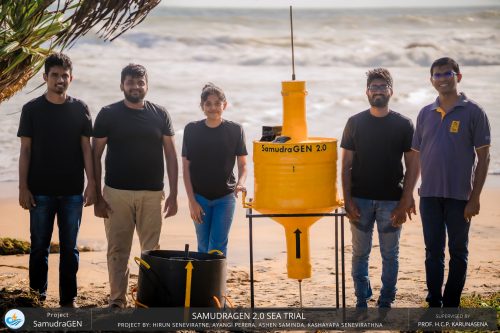Project Abstract
This project presents the development and field testing of SamudraGEN, a shallow-water wave energy converter (WEC) designed for the southern coast of Sri Lanka. The system employs a dual rack-and-pinion power take-off mechanism integrated with a buoyant surface floater to capture both heave and surge motions. Two iterative prototypes were developed: SamudraGEN 1.0 as a proof-of-concept and SamudraGEN 2.0 with structural and IoT-based enhancements. Computational Fluid Dynamics (CFD) simulations validated hydrodynamic performance under varying damping conditions, while sea trials at Ginthota confirmed average outputs of 20 W with peaks exceeding 60 W. Real-time monitoring using IoT and cloud-based dashboards enabled performance assessment under real marine conditions. The results demonstrate that SamudraGEN offers a cost-effective, scalable solution for decentralized renewable energy generation in tropical coastal environments. Future scaling, guided by hydrodynamic similarity laws, positions this system as a viable contributor to distributed coastal energy networks.
Overview
Global energy demand continues to rise, with urgent need for renewable alternatives to mitigate climate change. While solar and wind have matured, wave energy remains underutilized despite its high density and predictability. In Sri Lanka, southern coastal waters present wave energy potentials of 12–15 kW/m, yet field-tested converters are scarce, and most initiatives remain limited to simulations. The main challenges are the lack of low-cost, reliable WEC designs optimized for shallow-water conditions and the high failure rates of complex power take-off systems. These barriers restrict adoption in developing nations where affordability and mechanical resilience are critical. This project addresses these gaps by developing SamudraGEN, a modular and scalable point absorber WEC tailored for nearshore tropical seas. Its simplified dual rack-and-pinion PTO minimizes complexity, reduces maintenance requirements, and ensures structural stability. By incorporating real-time IoT monitoring, the system also advances digital integration in marine energy technologies. The project’s significance lies in demonstrating the feasibility of cost-effective shallow-water WECs for Sri Lanka, paving the way for decentralized renewable energy solutions for coastal communities. Beyond local benefits, the findings contribute to the global discourse on diversifying renewable energy portfolios and lowering Levelized Cost of Energy (LCOE) for wave power.
Field trials of SamudraGEN validated its ability to generate consistent electrical power in real shallow-water conditions. SamudraGEN 1.0 achieved stable 12 V outputs with peaks of 20 W, while the upgraded SamudraGEN 2.0 demonstrated enhanced performance, with sustained averages of ~20 W and peaks exceeding 60 W during energetic wave cycles. CFD simulations confirmed effective energy capture across different damping values, highlighting trade-offs between energy absorption and structural stress.
Awards
- IESL YMS Technical Conference 2024 Best Paper Award in Mechanical, Building Service, Manufacturing and Chemical Engineering


